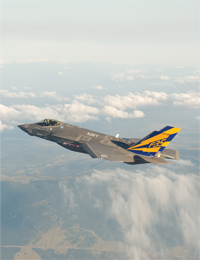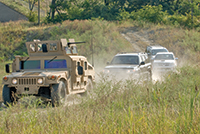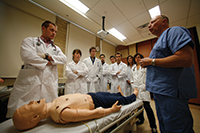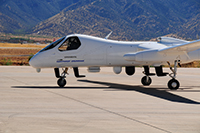
Features
Operations
Finding an alternative approach
It’s no secret the aerospace and defence (A&D) industries spend billions of dollars on research and development and have been responsible for some of the most advanced technologies in modern history, such as computers, satellites and satellite navigation.
November 3, 2011 By Brian Dunn

|
|
| BAE Systems is just one of many aerospace firms involved in the Lockheed Martin F-35 Lightning II fighter program.
|
It’s no secret the aerospace and defence (A&D) industries spend billions of dollars on research and development and have been responsible for some of the most advanced technologies in modern history, such as computers, satellites and satellite navigation. Or that new technologies and innovation are essential to boost revenue and cut costs through the advances of lighter, stronger and smarter materials.
In a report entitled, Gaining Technological Advant-ages, PricewaterhouseCoopers (PWC) looks at the A&D sector and suggests ways it can find other sources of revenue by looking at adjacent markets. Neil Hampson, the report’s author, suggests there’s a high level of synergy between new technologies and adjacent markets, and companies can benefit from their research when it can also be applied to those markets, especially since the aerospace industry has historically been very cyclical. The defence sector is also betting on diversification as a way to hedge against fluctuations in military budgets.
In fact, investments in new technologies and adjacent markets “are core to our growth strategy and embedded in the business,” according to Ian King, CEO of BAE Systems. And the financial crisis hasn’t dampened the focus of A&D companies on new technologies and adjacent markets, with most R&D budgets increasing last year and this year after declining in 2009. But defence budgets are getting squeezed, the report notes, with the U.S. (which accounts for 40 per cent of all military expenditures) looking to save some $100 billion through cost cutting over the current decade.
Although some competitors, among them Boeing and Airbus, are co-operating in key initiatives such as aviation biofuels, companies will have to be very selective about which new technologies and adjacent markets to focus on, Hampson points out.
For example, as David Thompson, chairman and CEO of Orbital Sciences, notes, “Commercial human spaceflight systems will become a reality in this decade, but the market for them may be slower to develop than currently projected.”
 |
|
| The lucrative defence and securities market has opened the door for many firms, such as BAE Systems, to diversify their product base to stay profitable. |
Composites is one area that’s getting a lot of attention, with demand for the lightweight material in the A&D sector expected to be worth $41.8 billion by 2020, according to Lucintel, a Dallas-based marketing and research firm. This is an area where automotive manufacturing has many similarities with A&D. Both industries rely on extensive R&D, and in both cases, the emphasis is on reduced weight and greater fuel efficiency. And A&D companies that have learned how to take advantage of the unique properties of composites may be well positioned to partner with automotive companies for two reasons: first, they have the design expertise to help automotive companies better understand the fundamental differences between metals and composite materials; and second, production processes developed for A&D applications may be suitable for automotive parts as well, thereby saving significant equipment costs.
Another area of “overlap,” according to Hampson is security, a promising adjacent market. Defence companies are taking advantage of stable spending to become more involved in the security sector. The global security market is now estimated to be worth between $140 billion and $180 billion per year and is expected to double its worth in the next decade, according to AeroSpace, Defence, Security Group in U.K.
BAE Systems, Thales, Boeing, Lockheed Martin, North-rop Grumman and Raytheon are all major players, competing with, and in some cases, working together with, security- and technology-focused companies. Some of the key fundamental drivers of the need for security such as terrorism and espionage, are also critical to defence efforts. Also, legislation around cyber security may strengthen the position of A&D companies in other adjacent markets like smart grids, if requirements increase.
Wind power is another major focus for a number of A&D companies. The number of wind power installations is expected to more than double over the next five years and A&D companies are taking note of a range of opportunities, notably the wind turbine blade market.

|
|
| CAE has diversified its product base to offer a variety of simulators in varying industries, including health care. Here, students train at the University of Montreal CAAHC simulation centre.
|
With climate change and energy security a priority for many governments, there’s greater funding for clean energy research and increasing demands on the defence sector to improve the environmental profile of military applications. Given the military’s increased focus on energy security, research around energy efficiency and renewability can now be seen as part of A&D’s core market. In addition, these new technologies are highly marketable in commercial settings, which means research dollars have the potential to generate more revenue in the long run.
Another example of opportunities in adjacent markets is CAE, which is branching out and now offers solutions for the mining and health-care industries. “For us, it’s growth. We believe that we’ve got leverage-able competencies, things that can deliver their value and provide significant growth opportunities,” says Nick Leontidis, executive vice-president of strategy and business development at CAE.
Smart grids may represent an extremely promising adjacent market for some defence companies. While government funding may be set to decline for the defence sector, it’s on the rise for energy-related projects, with the U.S. awarding $3.4 billion in smart grid grants in October 2009 as part of the federal government’s economic stimulus programs. The worldwide market is expected to more than double from $69.3 billion in 2009 to $171.4 billion by 2013, according to the online publication Environmental Leader.
“Succeeding in an adjacent market requires the right technology, but it also needs an understanding of how another industry works,” Hampson points out. “It also means being ready and able to work together, with government, academia, supply chain partners and competitors and across geographies, as the industry continues to globalize. That creates new risks. But taking a very defensive stance may jeopardize growth in the long run.”

|
|
| Unveiled on May 9, Northrop Grumman’s Firebird is an experimental intelligence gathering aircraft that can be flown remotely or with a pilot. It was designed by the company’s Scaled Composites design shop.
|
Investors usually dump stocks of a company when they feel the company has been underperforming, they are disappointed by quarterly results or they see nothing positive on the horizon. In the case of Héroux-Devtek (HD), none of those scenarios applied, but its shares had fallen close to 30 per cent since early summer, but had since recovered some ground. That selloff is unjustified, according to Cameron Doerksen, an aerospace analyst at National Bank Financial in Montreal.
While concerns over a weakening economy and defence spending cuts have “cast a shadow” over some sectors of the aerospace industry, HD has a lot of positives going for it, he writes in a report. They include a seven- to eight-year order backlog at Boeing and Airbus, both major customers of HD. The company’s exposure to the business jet market is mainly through the Bombardier Global family, where the backlog also supports increased production and through new programs that have yet to begin production will ramp up starting next year. And that’s the case even if the key Lockheed Martin F-35 fighter program were to be cancelled outright, a highly unlikely scenario. The program represents less than 10 per cent of company revenue and HD has the balance sheet to grow via acquisitions.
Shares of Bombardier and CAE have also been bruised in the past few months, along with stock markets in general. But the aerospace sector is well positioned to weather any turbulence, Doerksen suggests, adding it’s too soon to predict another 2009-2010 meltdown in the aerospace sector that resulted in thousands of layoffs in Montreal and from which the sector has yet to fully recover.
In fact, Bombardier says it will hold off on cutbacks at Mirabel until early next year, if they make any at all, after reporting sharply higher second-quarter profits at the end of August. The company earned $211 million in the quarter, a 53 per cent jump over last year’s $138 million. All figures are in U.S. dollars.
Although most of the improved profitability was the result of more contracts and better results at its rail division, Bombardier’s aerospace group was also profitable. The group’s financial position is still precarious, but as Doerksen notes, Bombardier’s $3.2 billion in cash reserves and $57 billion in backlog orders, including a record $34 billion in rail, mean that “there are no financial worries here at all.” The one area of concern for Bombardier is the regional aircraft division, which still has not picked up sufficiently from the post-2008 downturn and some order deferrals. By comparison, business aircraft have posted three strong quarters in a row.
As for CAE, it revealed in September that it has won more than $100 million in new military contracts, including one order for four additional full-flight simulators for the U.S. air force. CAE will also provide support services for the German air force’s Eurofighter simulators and upgrade existing Tornado fighter simulators.